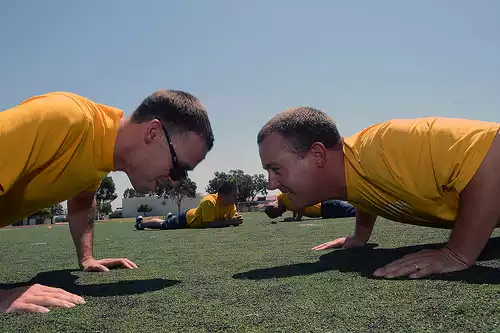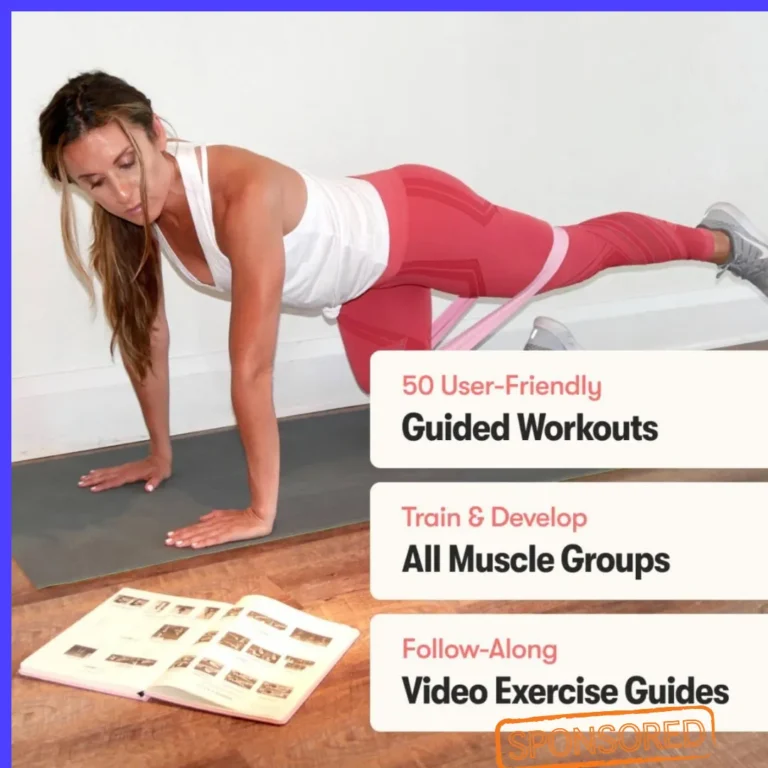Working Fitness Through Pain
Imagine the heart-pounding rhythm of your favorite workout playlist syncing perfectly with each stride on the treadmill, only to be interrupted by a sudden, sharp pain that forces you to slow down.
For many dedicated fitness enthusiasts and athletes alike, encountering discomfort is an inevitable part of pushing physical boundaries.
But what if this pain isn’t just a temporary roadblock but an ongoing companion? In our exploration of Working Fitness Through Pain, we delve into the complex relationship between maintaining physical activity and managing chronic or acute pain.
Understanding how to navigate workouts while dealing with persistent discomfort can mean the difference between progress and setback.
Whether you’re battling old injuries, arthritis, or other conditions that make exercise challenging, finding ways to adapt your fitness routine is crucial for both mental resilience and physical health.
This article aims to provide insights and strategies for continuing your fitness journey despite the hurdles of pain—empowering you not just to endure but thrive in your pursuit of wellness.
Table of Contents Working Fitness Through Pain
Working Fitness Through Pain
In today’s fast-paced world, the importance of maintaining a healthy lifestyle cannot be overstated.
However, for many individuals, the pursuit of physical fitness can be hindered by chronic pain.
Whether it is the result of an injury, a medical condition, or simply the wear and tear of everyday life, pain can make it difficult to stay active and maintain a regular exercise routine.
But what if I told you that it is possible to work through the pain and achieve your fitness goals without exacerbating your discomfort? In this article, we will explore the concept of working fitness through pain, and provide practical tips and strategies for managing and overcoming physical discomfort while staying active.
As a professional in the field of physical therapy, I have seen firsthand the impact that pain can have on an individual’s ability to lead a healthy and active lifestyle.
Through years of experience and research, I have developed strategies to help clients navigate the challenges of chronic pain and continue to progress towards their fitness goals.
Join me as we delve into the world of working fitness through pain and discover how you can overcome obstacles and achieve optimal physical health and well-being.
Acknowledge limits and seek solutions
It is important to recognize and accept the limitations of the body when engaging in fitness activities, especially when experiencing pain.
Ignoring or pushing through physical discomfort can exacerbate the issue and lead to more serious injuries.
Instead of viewing limitations as barriers, they should be seen as indicators to modify the workout routines or seek alternative forms of exercise that are less strenuous on the body.
By acknowledging these limits and proactively seeking solutions, individuals can tailor their fitness regimens to accommodate their body’s needs, promoting long-term health and well-being.
Consulting with a healthcare professional or a fitness trainer can provide guidance on appropriate modifications and exercises that can be beneficial in achieving fitness goals while minimizing the risk of further injury or discomfort.
Communicate openly with healthcare providers
Effective communication with healthcare providers is essential in managing fitness goals while dealing with pain or discomfort.
By openly sharing your concerns, symptoms, and limitations with your healthcare team, you enable them to provide tailored advice and recommendations that align with your specific needs.
Clearly articulating the type and intensity of pain experienced during exercise can help healthcare providers determine the underlying causes and suggest suitable modifications to your fitness routine.
Additionally, informing them about any previous injuries or medical conditions allows for a comprehensive approach to ensuring your safety and well-being during physical activities.
Remember, transparent and honest communication fosters a collaborative relationship with your healthcare providers, ultimately leading to more effective and personalized fitness strategies.
Modify exercises for reduced discomfort
To alleviate discomfort during exercise, it is crucial to tailor workouts to your individual needs.
Adjusting the intensity, duration, or type of exercises can help mitigate pain while still allowing for progress in your fitness journey.
For instance, opting for low-impact activities such as swimming or cycling instead of high-impact exercises can significantly reduce strain on joints and muscles.
Moreover, incorporating proper warm-up and cool-down routines, as well as implementing stretching exercises, can enhance flexibility and reduce the risk of injury.
By customizing your workout regimen to accommodate any discomfort or pain, you can continue to pursue your fitness goals effectively while prioritizing your well-being.
Prioritize safety and gradual progress
Emphasizing safety and gradual progress in your fitness regimen is paramount to ensure long-term success and avoid potential setbacks.
By prioritizing safety, you can create a sustainable workout plan that minimizes the risk of injuries and overexertion.
It is essential to listen to your body and understand its limitations, allowing for appropriate rest and recovery periods.
Gradual progress not only reduces the likelihood of experiencing pain but also enables your body to adapt and grow stronger over time.
Striving for small, achievable goals and gradually increasing the intensity or duration of your workouts will help you maintain consistency and prevent burnout, fostering a healthier and more balanced approach to fitness.
Remember, the journey to improved fitness should be a marathon, not a sprint, and prioritizing safety and gradual progress is key to ensuring lasting results.
Embrace recovery days for healing
To maintain optimal physical well-being and performance, it is imperative to recognize the significance of incorporating recovery days into your fitness routine.
Recovery days play a crucial role in allowing your body to heal and repair itself after intense physical activities.
During these periods, muscle tissues are given the opportunity to rebuild and strengthen, reducing the risk of overuse injuries and enhancing overall recovery.
Embracing recovery days fosters a balanced approach to fitness and aids in preventing burnout, ensuring that your body remains resilient and ready for future workouts.
By acknowledging the importance of rest and recovery, you prioritize your long-term health and well-being, ultimately enhancing the effectiveness of your fitness journey.
Stay informed about proper form
To ensure the effectiveness and safety of your workouts, it is essential to stay updated on proper form and technique while exercising.
Proper form not only enhances the efficiency of your workouts but also minimizes the risk of injuries that may result from incorrect movements.
Being knowledgeable about the correct posture, alignment, and execution of exercises can significantly improve the targeting of specific muscle groups and prevent unnecessary strain on joints and ligaments.
Regularly reviewing and practicing proper form with the guidance of fitness professionals or resources can help you maximize the benefits of your workouts while maintaining a safe and sustainable fitness regimen.
Remember, precision in form is key to unlocking the full potential of your exercise routine.
Stay attuned to body signals
Ensuring a successful fitness routine involves more than just adhering to proper form; it also requires a keen awareness of your body’s signals.
Paying attention to how your body responds during and after workouts is crucial in understanding its limits and needs.
If you experience persistent pain, discomfort, or unusual fatigue, it is essential to listen to these signals and adjust your routine accordingly.
Ignoring these warning signs can lead to exacerbated injuries and setbacks in your fitness journey.
By staying attuned to your body signals and responding appropriately, you can maintain a balanced approach to exercise that prioritizes both progress and well-being.
Cultivate mental resilience amid challenges
In the journey of working fitness through pain, cultivating mental resilience amid challenges becomes paramount.
It is natural to encounter obstacles and setbacks along the way, whether they are physical, emotional, or mental in nature.
Developing a resilient mindset involves acknowledging these difficulties without allowing them to derail your progress.
By practicing mindfulness, positive self-talk, and self-care strategies, you can build a strong mental foundation that enables you to navigate challenges with grace and determination.
Embracing setbacks as opportunities for growth and learning, rather than insurmountable barriers, can help you stay committed to your fitness goals in the face of adversity.
Remember that mental resilience is a valuable asset that empowers you to overcome obstacles and emerge stronger on the other side.
In conclusion, while pushing through pain and discomfort may seem like a mark of dedication, it is crucial to remember that listening to one’s body and seeking professional guidance when experiencing persistent pain is paramount.
Engaging in fitness activities that are within one’s physical limits and seeking modifications when necessary can promote long-term health and prevent potential injuries.
It is essential to prioritize overall well-being and understand that fitness should enhance one’s quality of life rather than compromise it.
Remember, pain is the body’s way of signaling that something is amiss, and it should not be ignored in the pursuit of fitness goals.
Consulting a healthcare professional or a fitness trainer for personalized guidance can help individuals navigate their fitness journey safely and effectively.
FAQ
How can individuals determine if they are experiencing normal muscle soreness from exercise versus pain that could be indicative of an injury?
Normal muscle soreness typically feels like a dull achiness or stiffness in the muscles, improves with movement, and peaks 24-72 hours after exercise.
In contrast, pain from an injury might be sharp, intense, localized, and may worsen with movement or specific activities.
If the pain is severe, persistent, or accompanied by swelling, bruising, or reduced range of motion, it could be a sign of an injury that requires medical attention.
Listening to your body, monitoring symptoms, and seeking professional advice if unsure can help differentiate between normal soreness and potential injury.
What are some strategies for modifying workouts to accommodate pain or injury without sacrificing fitness progress?
When modifying workouts due to pain or injury, focus on low-impact exercises, reduce intensity, avoid movements that aggravate the injury, incorporate rest periods, and consult with a physical therapist or fitness professional for personalized modifications.
It’s important to prioritize recovery and rehabilitation to prevent further injury while still maintaining overall fitness progress.
Listening to your body, staying consistent with modified routines, and gradually reintroducing higher intensity exercises as you heal can help to minimize setbacks and keep you on track towards your fitness goals.
Are there specific exercises or stretches that can help alleviate pain and improve mobility for individuals working through chronic pain?
Yes, certain low-impact exercises like yoga, tai chi, and swimming can help improve flexibility and reduce pain for individuals with chronic pain.
Stretching exercises focusing on the affected areas can also help alleviate stiffness and improve mobility.
It is important to consult with a healthcare provider or physical therapist to develop a personalized exercise plan that is safe and effective for managing chronic pain.
Consistency and proper form are key to experiencing the benefits of these exercises.
How important is it to listen to your body and rest when experiencing pain during workouts, rather than pushing through the discomfort?
It is crucial to listen to your body and rest when experiencing pain during workouts as pushing through discomfort can lead to further injury and hinder recovery.
Ignoring pain signals can potentially worsen the condition and prolong the healing process.
Resting allows the body to recover, repair, and prevent more serious issues in the long run.
Prioritizing proper rest and recovery is essential for maintaining overall health and fitness.
What role does proper nutrition and hydration play in managing pain and promoting recovery for individuals working on fitness goals despite chronic pain?
Proper nutrition and hydration are crucial in managing pain and promoting recovery for individuals with chronic pain pursuing fitness goals.
Nutrient-dense foods aid in reducing inflammation and supporting muscle repair, while adequate hydration ensures optimal function of bodily systems.
These elements contribute to increased energy levels, improved muscle function, and enhanced overall performance during workouts.
Additionally, maintaining a balanced diet and staying hydrated can help manage pain by reducing stress on the body and supporting the healing process.
Therefore, focusing on nutrition and hydration is essential for individuals striving to achieve fitness goals while dealing with chronic pain.







